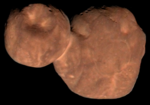cosmos.wikisort.org - Spacecraft
RAPIS-1 (RAPid Innovative payload demonstration Satellite 1) is a satellite launched on 18 January 2019[3] which for over a year was used to test seven technology demonstration projects. RAPIS-1 was developed and operated by Axelspace Corporation, under the coordination of the Japanese space agency JAXA.[4]
| Mission type | Technology demonstrator |
|---|---|
| Operator | Axelspace / JAXA |
| COSPAR ID | 2019-003A |
| SATCAT no. | 43932 |
| Website | www |
| Spacecraft properties | |
| Manufacturer | Axelspace |
| Launch mass | 200.5 kg (442 lb)[1] |
| Start of mission | |
| Launch date | 18 January 2019, 00:50:20 UTC |
| Rocket | Epsilon |
| Launch site | Uchinoura |
| End of mission | |
| Deactivated | 23 June 2020[2] |
| Orbital parameters | |
| Reference system | Geocentric |
| Regime | Sun-synchronous |
Overview
RAPIS-1 was the main satellite of the Innovative Satellite Technology Demonstration-1 mission. RAPIS-1 demonstrated various projects attached to it as either parts or components. The call for proposals for this mission was announced in 2015, and selection results were announced in February 2016.[5] Of the 13 projects selected for Innovative Satellite Technology Demonstration-1, 7 were on board RAPIS-1. A total of eight projects was initially selected, but a proposal by IHI Corporation, the "Demonstration experiment of a innovative ship information receiving system"[5] was later dropped, making the number of projects sent to space on board RAPIS-1 seven. Along with testing the seven projects, RAPIS-1's satellite system also was tested as part of the overall mission. RAPIS-1was developed by Axelspace Corporation, a startup company focusing on small satellite development and application, and is the largest satellite to date the company developed.[4] According to reports by Japanese media, RAPIS-1 was the first case for JAXA to contract a private company to manage the entirety of a satellite, from its development to its operation.[6]
Payload
- The NanoBridge based Field Programmable Gate Array (NBFPGA) is a compact FPGA using atomic switches. NBFPGA was developed by NEC Corporation.
- High data rate X-band Transmitter (HXTX) / X-band Middle Gain Antenna (XMGA) was developed by Keio University.
- The Green Propellant Reaction Control System (GPRCS) is a propulsion system to demonstrate the use of less-toxic fuel. GPRCS was developed by Japan Space Systems, a space agency under the Japanese Ministry of Economy, Trade and Industry.
- The Space Particle Monitor (SPM) was developed by Japan Space Systems, and is an orbital environment monitor using commercial-off-the-shelf products. Most orbital measuring instruments thus far were designed for large satellites and are bulky and costly, while SPM is small, light, and inexpensive, making it suitable for small satellites to carry.[7] According to Japan Space Systems, by monitoring radiation SPM will help determine the cause of satellite failures.[8]
- The Deep Learning Attitude Sensor (DLAS) is a dual use Earth sensor and star tracker applying deep learning.[9] Images taken will be analyzed by deep learning, and the results will be sent to ground stations, effectively conducting edge computing in space.[10] DLAS was developed by Tokyo Institute of Technology (TITech), and is aiming for commercialization.[11][9]
- The Thin Membrane Solar Array Paddle (TMSAP) is a thin-film solar cell that will be unfolded in space. It consists of five panels, each with one-fifths the weight of traditional honeycomb rigid panels. TMSAP was developed by JAXA.
- Fireant (Miniature Spaceborne GNSS Receiver) was developed by Chubu University.
See also
References
- "革新的衛星技術実証 1号機について" (PDF) (in Japanese). JAXA. 19 December 2018. Retrieved 2019-01-18.
- 小型実証衛星1号機(RAPIS-1)の運用終了について (in Japanese). JAXA. 25 June 2020. Retrieved 25 June 2020.
- "Launch Success, The Innovative Satellite Technology Demonstoration-1 aboard Epsilon-4" (Press release). JAXA. January 18, 2019. Retrieved 2019-01-18.
- "自社で宇宙インフラを構築 サービス提供を目指す" (in Japanese). RDD/JAXA. 2018. Retrieved 2019-01-18.
- "「革新的衛星技術実証1号機のテーマ公募」選定結果について" (in Japanese). RDD/JAXA. February 2016. Retrieved 2019-01-18.
- Ohnuki, Tsuyoshi (July 27, 2016). "JAXA初、ベンチャー企業に衛星をまるごと発注". sorae (in Japanese). Retrieved 2019-01-18.
- "小型軽量の放射線計測装置の世界展開への大きなステップに" (in Japanese). RDD/JAXA. 2018. Retrieved 2019-01-21.
- "GPRCS_SPM20190118.pdf" (PDF) (in Japanese). Japan Space Systems. January 2019. Retrieved 2019-01-21.
- "深層学習でリアルタイム軌道上画像識別を実現" (Press release) (in Japanese). Tohoku University. December 25, 2018. Retrieved 2019-01-21.
- Nishida, Munechika (December 25, 2018). "JAXAで聞いた「衛星からのエッジコンピューティング」話". Impress Watch (in Japanese). Retrieved 2019-01-21.
- "「革新的地球センサ・スタートラッカーの開発」で技術支援を実施" (Press release) (in Japanese). Amanogi. January 17, 2019. Retrieved 2019-01-21.
External links
- Official website (in Japanese)
- Innovative Satellite Technology Demonstration-1 - JAXA
- Special website of launch (in Japanese)
- RAPIS-1 - Axelspace
- DLAS Project (in Japanese)
Другой контент может иметь иную лицензию. Перед использованием материалов сайта WikiSort.org внимательно изучите правила лицензирования конкретных элементов наполнения сайта.
WikiSort.org - проект по пересортировке и дополнению контента Википедии


